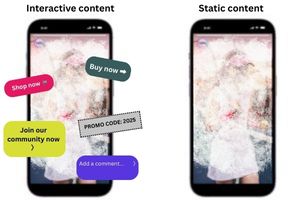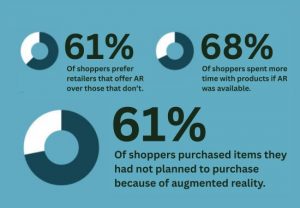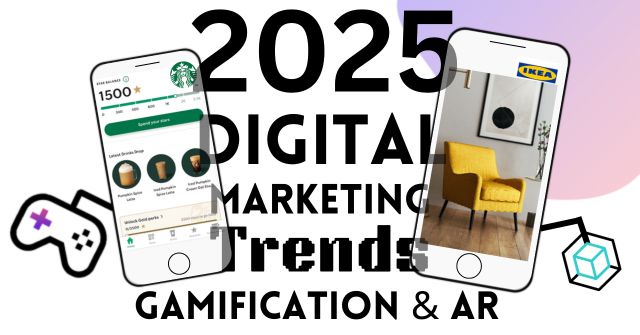Imagine scrolling through your feed and seeing an ad that lets you virtually try on sunglasses or play a fun quiz to unlock a discount. Sounds exciting, right?
That’s because interactive content transforms passive consumers into active ones. By 2025, as consumers crave immersive experiences, brands are leveraging gamification and augmented reality (AR) to enhance engagement and boost conversions.
Benjamin Franklin once said:
“Tell me and I forget, teach me and I may remember, involve me and I learn”
This quote perfectly highlights why interactive engagement is becoming the heart of digital marketing. Let’s explore how brands can stay ahead with gamification and AR!
1. Why Interactive Content Matters in 2025
The Shift from Passive to Active Engagement
Traditional content (like static ads and promotional emails) is becoming less effective due to short engagement times, while interactive content holds users’ attention longer.

The Impact of AR and Gamification on Consumer Behavior
- AR is transforming the retail experience by enhancing customer engagement, influencing purchase decisions, and increasing time spent interacting with products. By bridging the gap between digital and physical shopping, AR encourages spontaneous purchases and builds stronger connections between consumers and brands. The image below shows how AR makes shoppers prefer certain retailers, spend more time on products, and buy items they hadn’t planned to.

- Gamification significantly influences customer behavior by enhancing engagement, fostering brand loyalty, and encouraging repeat interactions. By integrating game-like elements into shopping experiences, businesses can drive customer participation and satisfaction. The image below shows why consumers engage in gamification while shopping, highlighting that many seek discounts and rewards, while others participate in brand communities or establish deeper connections with the brand.

2. The Rise of Gamification in Digital Marketing
Gamification integrates game-like elements (points, rewards, challenges) into marketing strategies to motivate user actions, increasing engagement, fostering brand loyalty, and enhancing learning experiences.
Successful Gamification Strategies
- Starbucks Rewards
Starbucks employs gamification in their loyalty program. Customers collect stars for each purchase, which can be exchanged for free food and drinks. The program also features bonus stars for completing certain challenges, such as trying a specific product, thus adding an element of novelty and excitement to the shopping experience.
- Duolingo
Duolingo gamifies language learning by structuring lessons as short, game-like activities. Users gain experience points for completed lessons and maintain streaks for regular study. The introduction of lives, which decrease for incorrect answers, adds a level of challenge. Moreover, leaderboards foster a sense of competition among friends, which promotes continued engagement.
- Nike Run Club
This application uses gamification to motivate users to work out. It records users’ runs, presents personalized coaching, and supports friendly competitions. The app assigns badges for achievements and keeps track of running streaks, making workouts feel like a series of mini-victories.
LinkedIn encourages users to complete their profiles through gamification. The ‘Profile Strength’ bar indicates the level of completeness and suggests improvements. The progress towards ‘All-Star’ status fosters a sense of achievement and encourages users to present a comprehensive professional online presence.
3. Augmented Reality (AR) in Digital Marketing
AR creates immersive brand experiences, allowing users to interact with digital elements in real-world settings, ultimately enhancing product visualization and motivating consumers to engage with and purchase products more confidently.
Successful Augmented Reality Strategies
- Furniture placement
IKEA’s AR app, IKEA Place, lets users visualize furniture at home before buying. With a catalog of 3,000 products, it scales items to fit room dimensions. The updated app includes visual search, helping users find similar furniture by uploading photos.
- Interactive ads
Pepsi uses AR for interactive ads and immersive experiences. The “For the Love of It” campaign turns blue surfaces into AR screens. Pepsi also launched an AR concert on a bottle, where users scan a Pepsi Black Raspberry bottle to watch a virtual performance.
- Virtual try-ons
L’Oréal’s AR allows users to try on makeup in real-time, providing accurate visuals for products like lipstick and eyeliner before purchasing.
Too Long to Read?
-
Consumers prefer interactive experiences over static content
-
AR and gamification increase engagement and boost sales
-
Gamification adds fun (points, rewards, challenges) to keep users involved
-
Brands like Starbucks, Duolingo, Nike, and LinkedIn use it to drive loyalty
-
AR lets users visualize products, increasing confidence and impulse buys
-
IKEA, Pepsi, and L’Oréal show how AR can transform the shopping experience
-
Interactive content is key to capturing attention and driving conversions in 2025
Interested? Check out similar blogs:
2025 Digital Marketing Trends: The Future of CRM – From Transactional to Relational Marketing
2025 Digital Marketing Trends: How AI Is Revolutionizing Customer Experience
2025 Digital Marketing Trends: How to Build Customer Journeys




Interesting blog on how tech like AR & gamification will redefine marketing in 2025!
Thank you Emilia for your comment. Yes, you’re absolutely right AR and gamification are set to transform how brands connect with audiences in exciting new ways
Super blog. Hâte de voir comment la gamification et la réalité augmentée vont transformer l’engagement des utilisateurs
Merci André! C’est clair, ces technologies ouvrent la voie à des expériences utilisateurs plus immersives et engageantes. As-tu déjà testé une campagne gamifiée ou en réalité augmentée ?
Oui, j’ai testé une campagne gamifiée pour un lancement de produit de Nivea et ça m’a vraiment fait réaliser à quel point le jeu peut transformer l’interaction client
C’est bien André ! C’est fou comme une simple touche de jeu peut rendre une campagne mémorable. Nivea a vraiment bien joué le coup.
Nice one Yazid, I’ve used the starbucks rewards program you mentioned, and It’s surprisingly engaging, collecting stars and completing challenges like trying new drinks really does make the experience feel more interactive and rewarding. It’s a clever way to keep customers coming back, not just for coffee, but for the fun of the challenge too.
Thank u Steve. Starbucks really nailed it with their rewards program—it turns a simple coffee run into a mini-game. It’s a great example of how brands can use gamification to boost engagement and build customer loyalty without it feeling forced. Have you tried any other apps or brands that used AR?
I’ve tried also the IKEA’s app lets you place furniture in your room using AR, which is super handy and surprisingly fun. It’s cool to see how AR and gamification are blending into everyday experiences in different industries
Nice, Steve. The IKEA app is a great example, it’s amazing how AR can make everyday decisions so much easier and more enjoyable. I’m curious to see how more industries will adopt these tools in the future.
Bro me too!
I like it, the quote you mentionned perfectly sums up why interactive content like gamification and AR is the future
Absolutely Llorian, interactive content makes learning and engagement so much deeper. Isn’t it amazing how much more we remember when we’re actually part of the experience?